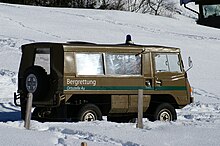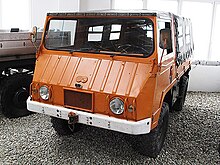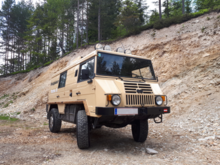Steyr-Puch Pinzgauer
| Steyr-Puch | |
|---|---|
|
Biaxial Pinzgauer
|
|
| Pinzgauer | |
| Production period: | since 1971 |
| Class : | Off-road vehicle |
| Body versions : | Box trucks , flatbed trucks |
| Engines: |
Otto engines : 2.5–2.7 liters (62–76 kW) Diesel engines : 2.4–2.5 liters (85 kW) |
| Length: | 4528-5308 mm |
| Width: | 1800 mm |
| Height: | 2160 mm |
| Wheelbase : | |
| Empty weight : | 2050 kg |
| Previous model | Steyr-Puch Haflinger |

The Steyr-Puch Pinzgauer is an Austrian military vehicle . It was developed as the successor to the Steyr-Puch Haflinger and is a wagon for the toughest terrain, which is offered in versions with two or three switchable / driven ( lockable ) axles. With the all-wheel drive implemented in this way , the vehicle has the drive formula 4x4 or 6 × 6 , depending on the version with 4 or 6 wheels .
history
As with the Steyr-Puch Haflinger , the name of the Pinzgauer comes from a typical farm animal in Austria, the Pinzgauer , named after the Pinzgau in Salzburg . These cattle were mostly kept on high and hillside locations and are characterized by their tensile strength and resistance to stepping.
The Pinzgauer from Steyr-Daimler-Puch prevailed against the Husar , the competitor product of the ÖAF , as the standard vehicle of the Austrian Armed Forces .
In contrast to the Haflinger, which has the engine in the rear, the engine of the Pinzgauer is mounted above the front axle. Its central tubular frame construction enables a large number of construction variants. Like the Haflinger, the Pinzgauer was developed in Graz under the main direction of Erich Ledwinka , the son of Hans Ledwinka , who works for the Tatra and Steyr factories .
The Pinzgauer is used by many military organizations: both in the Austrian Armed Forces and in the armed forces of the United Kingdom , Switzerland , Saudi Arabia , Jordan and many others.
In 2000, after more than 30,000 different versions had been built, production was sold to Automotive Technik LTD in Great Britain and continued. In 2002, Automotive Technik was taken over by Armor Holdings.
In 2006 Armor Holdings also bought Stewart & Stevensson, the maker of the US Army FMTV vehicles. The FMTV is based on the Steyr 12M18 . 12M18 and Pinzgauer are thus reunited in one company.
On 31 July 2007 Armor Holdings was created by British Aerospace acquired and BAe Systems AH Inc. renamed.
In 2008, the manufacture and development of the Pinzgauer was handed over to British Aerospace-BAe Land Systems OMC, Benoni, South Africa . BAe OMC thus manufactures the "old" Pinzgauer I and develops and builds the new Pinzgauer II. This Pinzgauer was designed in the 6 × 6 version with a Steyr Motors M16 TCI six-cylinder turbodiesel engine with 145 kW. It is the M1 monoblock engine, which was tested in the Pinzgau region with the five-cylinder version (M15) as early as the Steyr-Daimler-Puch times.
There is only one spare parts warehouse in the UK with around 25 employees. The firm Ricardo Ltd. in England builds a new body version of the Pinzgauer.
Model overview
The Pinzgauer was produced in many different versions, primarily for the military. The first series (710/712) was built from 1971 to 1985 exclusively with an air-cooled four-cylinder in-line engine (Puch's own development: 2.5 l with 62–66 kW, in the civilian version 2.7 liters, 76 kW with K-Jetronic ). In 1985 the vehicle was completely redesigned (716/718) and switched to diesel engines. It started with a liquid-cooled turbodiesel engine (2.4-liter six-cylinder turbo diesel ( VW LT ) 85 kW with LLK ). From 2003 this was replaced by a 2.5-liter 5-cylinder (VW turbo diesel). The petrol models are equipped with a 5-speed manual transmission. The six-cylinder turbodiesel models (1985-2003) were available from the start with either a 5-speed manual or a 4-speed automatic transmission. They are often driven on 235/85 R 16 tires.
The five-cylinder turbodiesel models (from 2003) were only delivered with a 4-speed automatic transmission.
- Gasoline models 710/712
Dimensions (4 × 4/6 × 6):
- Height: 2045 mm / 2045 mm
- Length: 4170 mm / 4950 mm
- Width: 1790 mm / 1790 mm
- permissible total weight: 3000 kg / 3500–3900 kg
- Gradeability: 100%
- Diesel models 716/718
Dimensions (4 × 4/6 × 6):
- Height: 2160 mm / 2160 mm
- Length: 4528 mm / 5308 mm
- Width: 1800 mm / 1800 mm
- permissible total weight: 3850 kg / 5000 kg
- Gradeability: 80%
4 × 4 petrol versions
- 710 M - tarpaulin cover
- 710 K - panel van
- 710 T - flatbed
- 710 AMB-Y - ambulance
- 710 AMB-S - ambulance with portable shelter
6 × 6 petrol versions
- 712 M - tarpaulin cover
- 712 K - panel van
- 712 FLA - Flak carrier
- 712 W - workshop trolley with portable shelter
- 712 DK - metal double cabin with a platform behind
- 712 T - flatbed
- 712 AMB-S - ambulance with portable shelter
- 712 FW - fire brigade
- 712 REC - recovery vehicle
4 × 4 diesel version
- 716 M - tarpaulin cover
- 716 K - closed body, five-door
- 716 MK - closed body, three doors
- as well as numerous other variants, since production to order according to customer requirements
6 × 6 diesel version
- 718 M - tarpaulin cover
- 718 K - closed body, five-door
- 718 MK - closed body, three doors
- as well as numerous other variants, since production to order according to customer requirements





